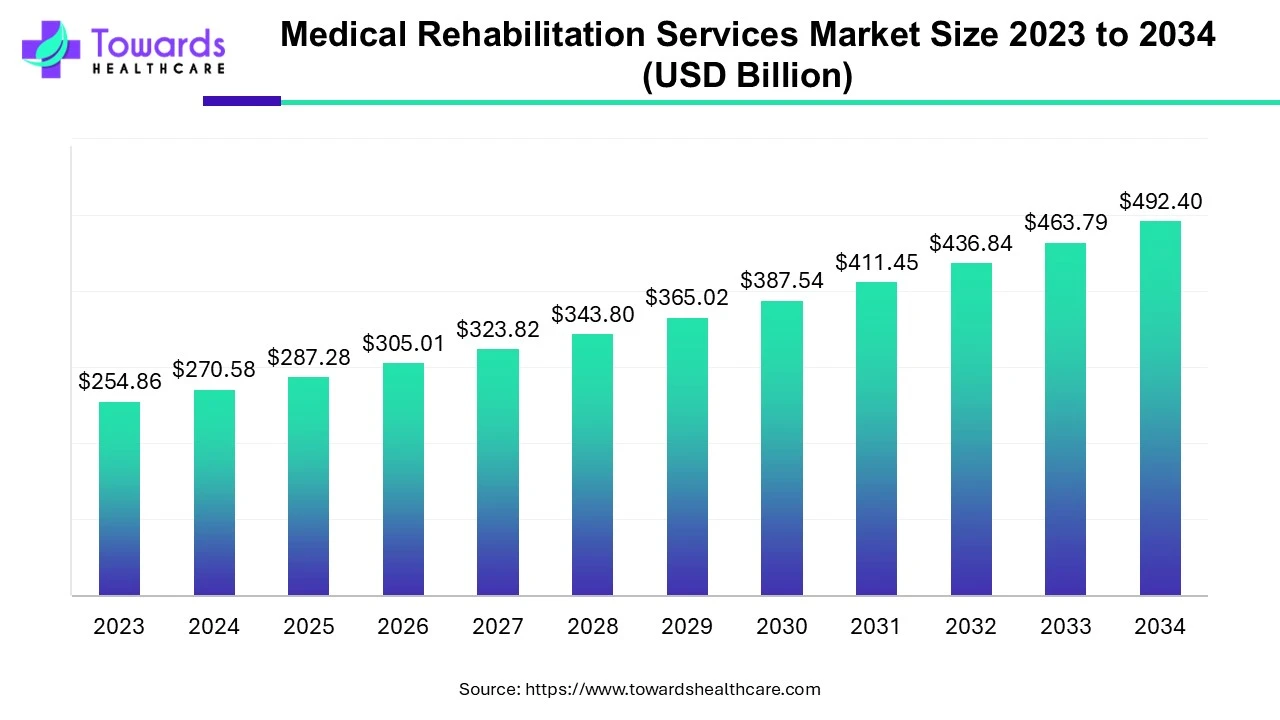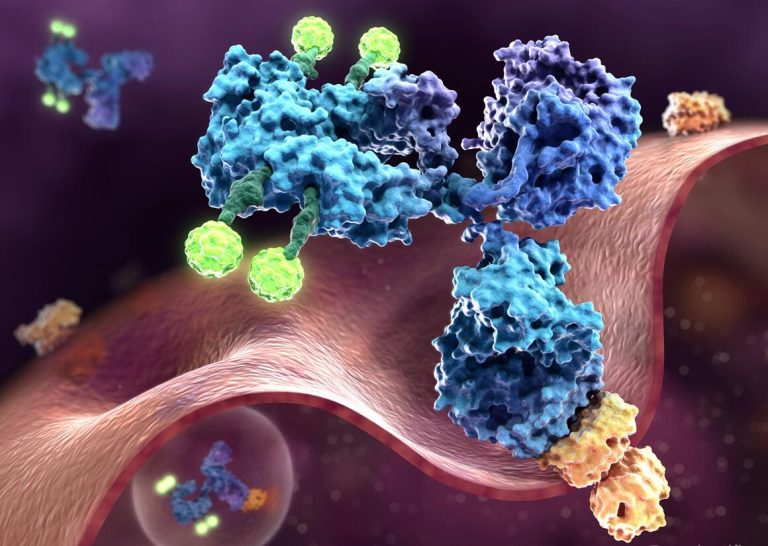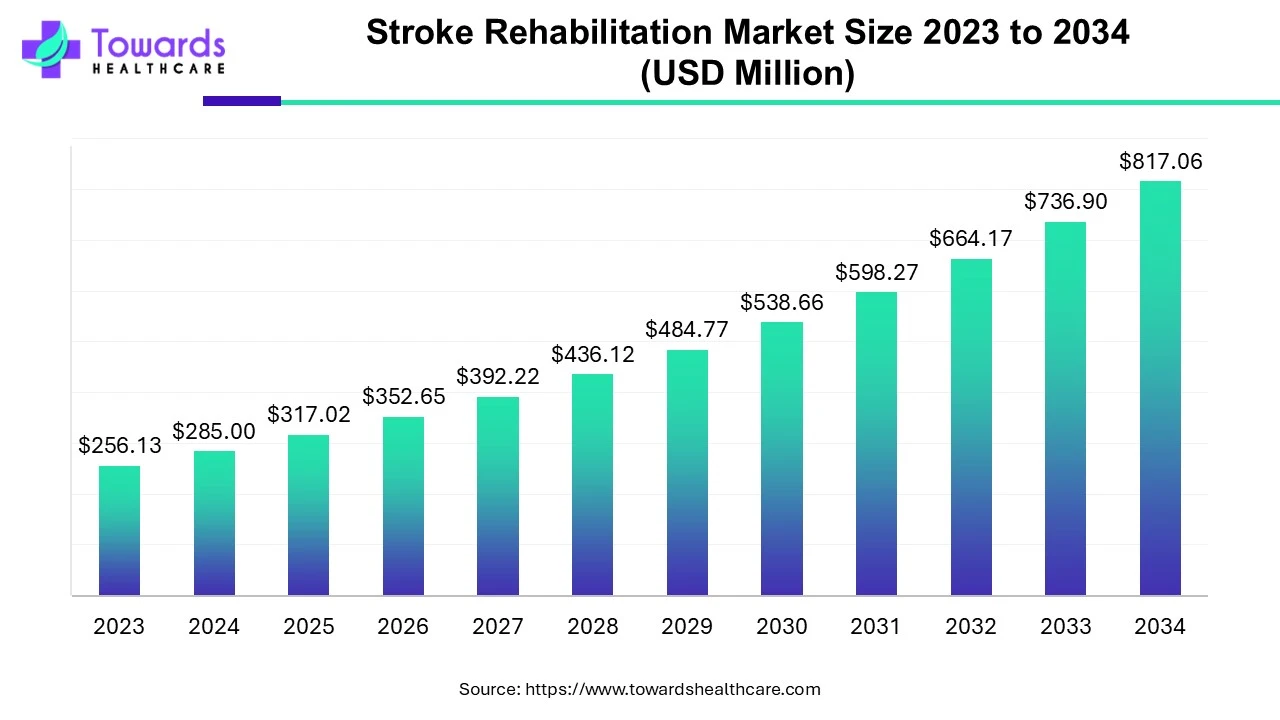In a paradigm shift for healthcare, the AI in cancer diagnostics market is on the verge of substantial growth, surging from its 2022 valuation of USD 892.23 million. Prognosticated to advance at a robust 9.35% Compound Annual Growth Rate (CAGR) from 2023 to 2032, the market is set to attain an estimated value of USD 2,084.34 million by the conclusion of this period.
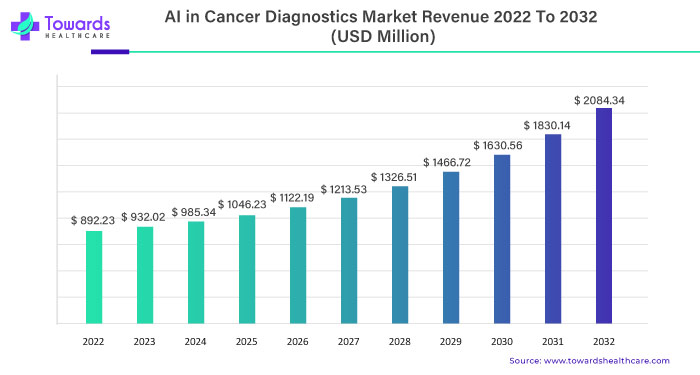
FDA published an updated list of around 178 new AI-based devices in July 2022 making it 500+ AI-based devices, out of which more than 75% are used in radiology.
AI in cancer diagnostics market is transforming the healthcare industry, where it is being used to improve the speed, accuracy, and efficiency of cancer diagnosis. The AI in cancer diagnostics market is rapidly growing due to the rising prevalence of cancer worldwide, increasing demand for precision medicine, and advancements in machine learning algorithms and big data analytics. This article provides precise and analytical data on the current state and future trends of the AI in cancer diagnostics market.
AI in cancer diagnostics market has applications in various areas, including medical imaging, (READ MORE) genomics, and liquid biopsy. Among these, medical imaging is the largest application segment due to the wide availability of imaging data, advancements in image recognition algorithms, and the rising use of imaging in cancer diagnosis. In terms of AI technologies, machine learning is the most widely used technology for cancer diagnostics, accounting for the largest market share. Machine learning algorithms can analyze large datasets and identify patterns that are not visible to the human eye, thus improving the accuracy and efficiency of cancer diagnosis.
AI is transforming the field of cancer diagnostics, improving the accuracy, speed, and efficiency of cancer diagnosis. The AI in the cancer diagnostics market is rapidly growing, driven by various factors such as the rising prevalence of cancer, increasing demand for precision medicine, and advancements in AI technologies.
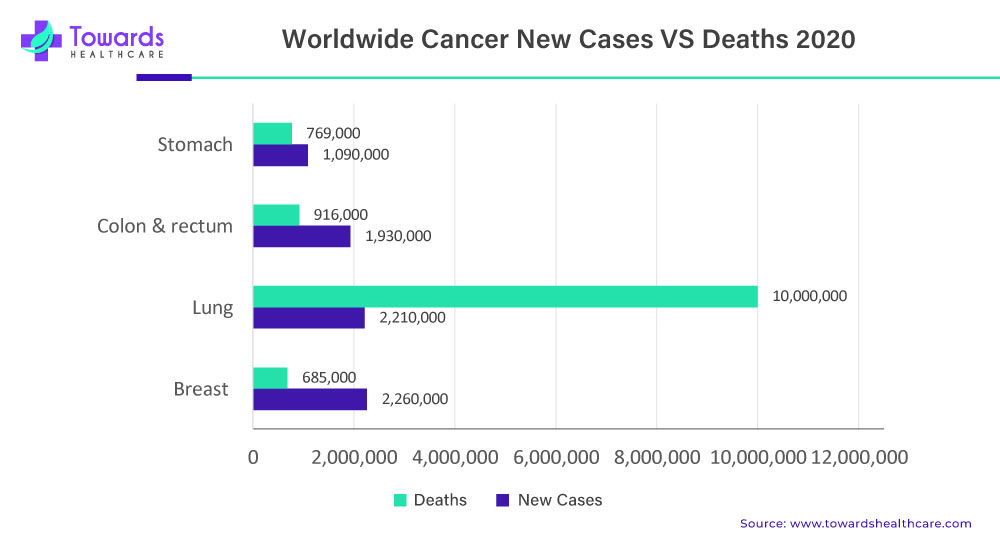
The rise of AI in cancer diagnostics Market: improving detection and treatment
The global AI in the cancer diagnostics market is expected to witness significant growth in the coming years, driven by several key factors. One of the major drivers of this market is the increasing prevalence of cancer across the world. For instance, according to the World Health Organization (WHO), cancer is the leading cause of death globally and was responsible for around 10 million deaths in 2020. The rising incidence of cancer, coupled with the growing demand for early detection and diagnosis, has led to the adoption of AI-based diagnostic tools and techniques.
Cancer remains one of the leading causes of death worldwide, with millions of people diagnosed each year. While early detection and treatment can greatly improve outcomes, many cancers go undetected until later stages, when treatment options may be limited. However, the emergence of AI in cancer diagnostics market is changing the game, offering new tools and methods for earlier detection, more accurate diagnosis, and personalized treatment plans.
One of the major drivers behind the rise of AI in cancer diagnostics market is the increasing availability of data. As more healthcare organizations digitize patient records, imaging data, and other clinical data, there is a wealth of information available that can be analyzed and used to improve cancer diagnosis and treatment. AI algorithms can analyze large volumes of data quickly and accurately, identifying patterns and trends that may not be immediately apparent to human clinicians.
AI in cancer diagnostics market is being used in a variety of ways, from analyzing medical images to identifying genetic markers associated with certain cancers. For example, AI algorithms can analyze mammograms to detect breast cancer at an earlier stage than traditional methods, increasing the chances of successful treatment. In addition, AI is being used to develop new cancer biomarkers, which can be used to predict the likelihood of cancer recurrence and help clinicians develop personalized treatment plans.
Another key benefit of AI in cancer diagnostics market is the ability to improve the accuracy of cancer diagnoses. Many cancers have similar symptoms or may appear similar on medical images, making it difficult for clinicians to accurately diagnose the type and stage of cancer. AI algorithms can analyze medical images and other data to identify subtle differences that may indicate a particular type of cancer, allowing for more accurate and timely diagnosis.
The rise of AI in cancer diagnostics market has the potential to revolutionize the way cancer is diagnosed and treated. By improving early detection, increasing diagnostic accuracy, and enabling personalized treatment plans, AI is helping to improve outcomes for cancer patients around the world. As more healthcare organizations and technology companies invest in AI for cancer diagnostics, we can expect to see continued progress and innovation in this field.
Advancements in Healthcare Technology Drive AI-Powered Cancer Diagnostics
The field of cancer diagnostics is being transformed by the integration of artificial intelligence (AI) technology. AI-powered cancer diagnostics have the potential to improve the detection, diagnosis, and treatment of cancer, which could have a significant impact on patient outcomes. Advancements in healthcare technology are also driving the adoption of AI in cancer diagnostics market. The increasing availability of medical imaging data, such as CT scans, MRI scans, and X-rays, provides a rich source of information that can be analyzed by AI algorithms.
This data can help to identify subtle patterns and abnormalities that may not be visible to the human eye, leading to more accurate and reliable cancer diagnoses. In January 2023, Paige and Microsoft’s collaborated in the field of AI-enabled cancer diagnostics aiming to leverage the power of machine learning to analyze digital pathology images and develop new clinical applications and computational biomarkers for cancer diagnosis and treatment.
Medical imaging technologies have revolutionized the way we diagnose and treat cancer, enabling doctors to detect tumors and track disease progression with greater precision. However, the interpretation of these images is often complex and time-consuming, requiring skilled radiologists to analyze multiple images and identify potential cancerous lesions. This is where AI comes in – by utilizing machine learning algorithms and deep learning techniques, AI systems can analyze medical images more quickly and accurately, improving the speed and accuracy of cancer diagnoses.
Unleashing Growth: Dynamics of the AI in Cancer Diagnostics Market
1. Precision Diagnosis Drives Market Surge
The exponential growth of the AI in cancer diagnostics market is primarily propelled by the adoption of precision diagnosis techniques. Artificial intelligence algorithms analyze complex medical data with unprecedented accuracy, enabling early and precise detection of cancerous conditions. This transformative approach enhances diagnostic capabilities, leading to more effective and timely interventions.
2. Integration of AI in Medical Imaging
A pivotal factor contributing to market expansion is the integration of AI in medical imaging for cancer diagnostics. Cutting-edge technologies, such as machine learning algorithms, facilitate the interpretation of medical images with heightened accuracy. This not only aids in early cancer detection but also streamlines the diagnostic process, reducing the time required for accurate assessments.
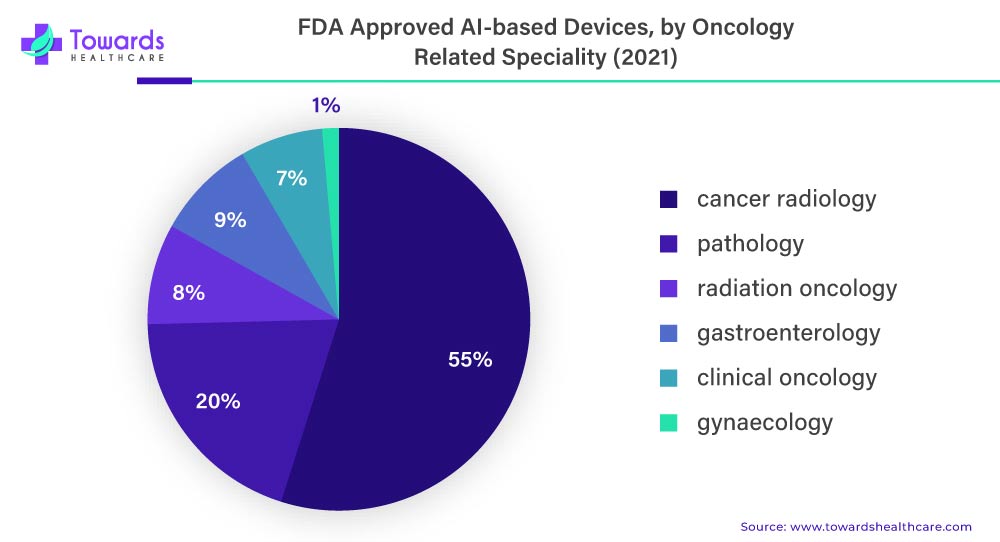
In addition, rising partnerships among market players for the development of advanced solutions expand the growth of this market. For instance,
- In April 2023, scientists from the Massachusetts Institute of Technology (MIT) and the Mass General Cancer Center announced the development of Sybil, an AI tool to detect early signs of lung cancer.
- In May 2022, Aidoc and Gleamer, two companies specializing in artificial intelligence (AI) for medical imaging, announced a partnership. The partnership aims to leverage the strengths of both companies to enhance the use of AI in medical imaging and improve patient outcomes.
- In March 2022, Proscia and Visiopharm announced their strategic partnership to integrate their respective AI-powered solutions for precision pathology, with the goal of improving clinical decision-making for cancer care.
- In October 2021, Roche and PathAI entered a partnership agreement to work together and develop an embedded image analysis workflow for pathologists using AI-powered technology for pathology. The goal of this collaboration was to improve the accuracy and efficiency of diagnosing and treating cancer and other diseases.
In addition to medical imaging, AI is also being used to analyze other types of data in cancer diagnostics, such as genomic data and patient medical records. By analyzing large datasets of genomic information, AI algorithms can identify genetic mutations that may increase the risk of developing certain types of cancer. Similarly, by analyzing patient medical records, AI systems can identify risk factors and patterns that may be indicative of cancer, helping doctors to make earlier and more accurate diagnoses.
The use of AI in cancer diagnostics market has the potential to improve patient outcomes by enabling earlier and more accurate diagnoses, leading to more effective treatment and better overall survival rates. As healthcare technology continues to advance, we can expect to see even more applications of AI in cancer diagnostics market and treatment in the future.
Projections and Trends: Navigating the Future of AI in Cancer Diagnostics Market
1. Advancements in Personalized Treatment Plans
The convergence of AI and cancer diagnostics is reshaping the approach to treatment plans. Tailoring therapies based on individual patient profiles, AI enhances the effectiveness of cancer treatments. This personalized medicine approach minimizes side effects, improves treatment outcomes, and represents a pivotal advancement in the oncology landscape.
2. Remote Diagnostics Revolutionized by Telehealth
As telehealth gains prominence, the AI in cancer diagnostics market is witnessing a shift toward remote diagnostics. AI-driven technologies enable healthcare professionals to analyze diagnostic data remotely, facilitating timely interventions and consultations. This transformative trend is not only convenient for patients but also contributes to more efficient and accessible healthcare services.
Bridging the Gap: Enhancing Data Availability for Enabled AI in Cancer Diagnostics Market
One of the key challenges in enabled AI in cancer diagnostics market is the availability of high-quality data. AI algorithms rely on large datasets to learn patterns and make accurate predictions, but in the field of cancer diagnostics, there is often a lack of standardized, comprehensive, and diverse data. This can hinder the development and implementation of AI-powered diagnostic tools. The lack of standardized, comprehensive, and diverse data is a major restraint for AI cancer diagnostics market. Without access to sufficient and diverse data, AI algorithms may not be able to identify subtle patterns or accurately predict outcomes.
This can lead to inaccurate diagnoses and treatment recommendations, which can ultimately harm patients. Additionally, data privacy concerns can limit the availability of data for AI-powered diagnostic tools, as healthcare organizations may be reluctant to share sensitive patient information.
To address this challenge, efforts are being made to bridge the gap between data availability and AI-powered cancer diagnostics. One approach is to establish partnerships between healthcare providers and technology companies to develop and implement data-sharing platforms. These platforms allow for the pooling of data from multiple sources, including electronic health records, imaging data, genomics data, and pathology data. By creating large and diverse datasets, AI algorithms can learn from a wider range of cancer cases, leading to more accurate and personalized diagnostics.
Another approach is to develop standardized data collection and sharing protocols. The use of standardized protocols can improve the quality and consistency of data, making it easier to analyze and compare across different datasets. This can also enable the creation of larger datasets, which can improve the accuracy of AI algorithms. Standardized protocols can also facilitate data sharing across different institutions and countries, leading to more comprehensive and diverse datasets.
In addition to these efforts, advances in technology are also improving the availability and quality of data for AI-enabled cancer diagnostics. For example, the increasing use of digital pathology, which allows for the digitization of pathology slides, is generating large amounts of data that can be used to train AI algorithms. Similarly, the development of new imaging techniques, such as high-resolution MRI and PET-CT scans, is also generating more detailed and informative data that can be used to develop AI-powered diagnostic tools.
Bridging the gap between data availability and AI-powered cancer diagnostics is critical for improving cancer diagnosis and treatment. By pooling data from multiple sources, developing standardized protocols, and leveraging advances in technology, we can create larger, more diverse, and higher-quality datasets that can be used to train AI algorithms and improve cancer diagnostics.
Saving Lives with Speed and Precision: The Future of Cancer Diagnosis
A cancer diagnosis has long been a laborious and time-consuming process, but with the advent of AI in cancer diagnostics market, the future looks brighter. AI-powered diagnostic tools can analyze large amounts of data in a matter of seconds, allowing for faster and more accurate diagnoses, ultimately leading to improved patient outcomes. This presents a significant opportunity in the healthcare industry.
Moreover, the global AI in cancer diagnostics market is expected to grow rapidly in the coming years, providing an opportunity for businesses to capitalize on this trend. The rise in cancer prevalence worldwide is one of the primary drivers of market growth. Additionally, the increasing demand for personalized medicine and the adoption of AI-powered diagnostic tools by healthcare providers are contributing to the market’s growth. AI-powered cancer diagnostics can improve the accuracy and speed of cancer diagnosis, enabling early detection and timely treatment.
Traditional cancer diagnostic methods involve a manual review of medical imaging and pathology samples by trained medical professionals, which can be time-consuming and prone to human error. AI algorithms, on the other hand, can rapidly analyze large amounts of data, identify subtle patterns and anomalies, and provide accurate and consistent results.
This has the potential to revolutionize cancer diagnosis by providing faster and more accurate diagnoses, which can lead to earlier intervention and better treatment outcomes. Additionally, AI-powered cancer diagnostics can reduce the workload of healthcare professionals, freeing up their time to focus on patient care.
Breast Cancer Diagnosis Revolutionized with AI in Cancer Diagnostics Market
Breast cancer is the most common cancer among women worldwide, and early detection plays a crucial role in improving patient outcomes. In recent years, AI has emerged as a promising technology for improving breast cancer diagnosis and treatment. AI-powered diagnostic tools can help radiologists detect breast cancer at an earlier stage and with greater accuracy, reducing the need for unnecessary biopsies and improving patient outcomes. The high prevalence of breast cancer significantly drives the demand for breast cancer diagnostics which in turn drives the growth of AI in the cancer diagnostics market.
For instance, as stated by the World Health Organization, breast cancer accounted for the highest prevalence of all cancers with around 2.26 million cases in 2020 around the world.
The use of AI in breast cancer diagnosis is expected to grow in the coming years, driven by several factors. Firstly, the rising prevalence of breast cancer worldwide is creating a need for more accurate and efficient diagnostic tools. Secondly, advances in medical imaging technology are enabling the collection of large amounts of data that can be analyzed using AI algorithms. Finally, the increasing adoption of electronic health records is making it easier to access and share patient data, which is crucial for the development of AI-powered diagnostic tools. The breast cancer diagnostics market presents a significant opportunity for AI vendors and healthcare providers.
The adoption of AI in breast cancer diagnosis is expected to grow in the coming years due to several factors, including the increasing prevalence of breast cancer, improvements in medical imaging technology, and the increasing availability of patient data through electronic health records. Additionally, AI algorithms can continuously learn from new data, making them more accurate over time.
Opportunities and Challenges on the Horizon
1. Expanding Horizons in Oncology Research
The integration of AI in cancer diagnostics market presents unprecedented opportunities for advancement in oncology research. Collaborations between AI experts and oncologists open new avenues for understanding complex cancer patterns and developing innovative diagnostic approaches. This synergy is instrumental in pushing the boundaries of cancer research and expanding our understanding of the disease.
2. Addressing Regulatory and Ethical Considerations
With the rapid evolution of AI in cancer diagnostics market, regulatory and ethical considerations become paramount. Safeguarding patient data, ensuring compliance with healthcare regulations, and navigating the ethical implications of AI-driven diagnostics are challenges that require vigilant attention. Striking a balance between innovation and ethical standards is crucial for the sustained growth and acceptance of AI in cancer diagnostics market.
In Conclusion: Paving the Way for Advanced Cancer Care
In conclusion, the AI in cancer diagnostics market is poised for transformative growth, driven by precision diagnosis, advanced imaging technologies, and personalized treatment approaches. As AI continues to revolutionize the landscape, opportunities for research and remote diagnostics abound. Navigating the future of AI in cancer diagnostics market demands a strategic approach to address regulatory challenges and uphold ethical standards, paving the way for advanced and accessible cancer care.
